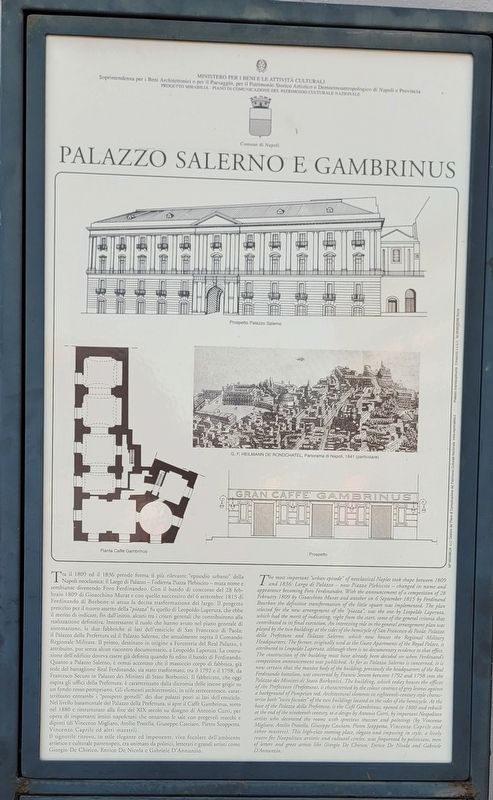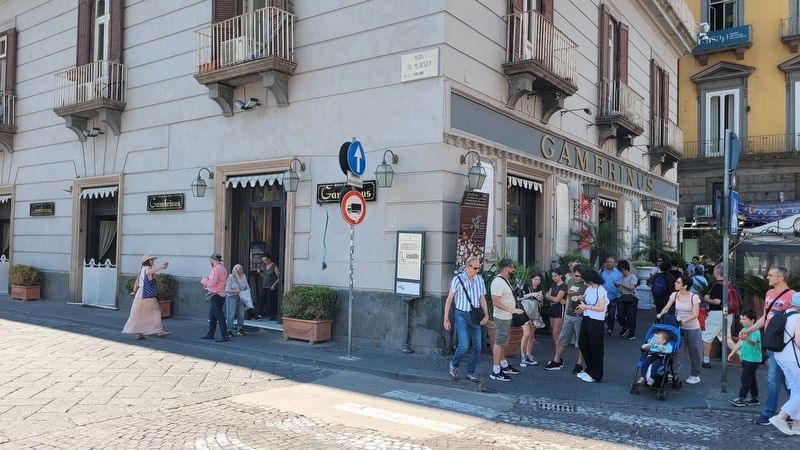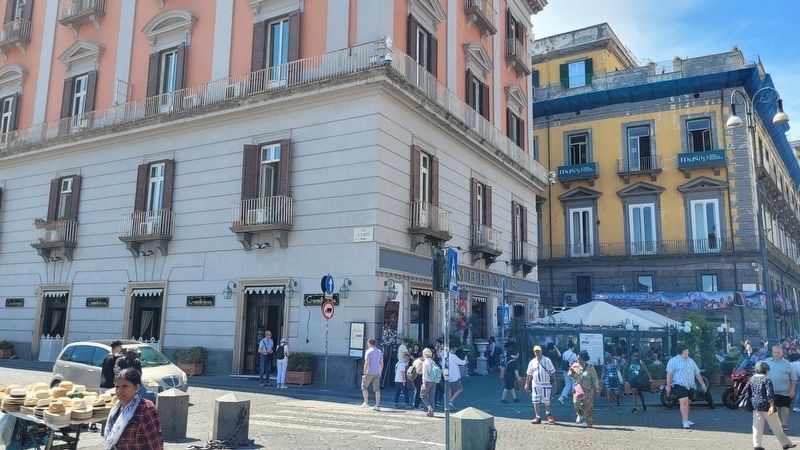San Ferdinando in Napoli in Città Metropolitana di Napoli, Campania, Italy — Southern Italy (Tyrrhenian Coast)
Palazzo Salerno e Gambrinus / Salerno and Gambrinus Palace
Inscription.
Il signorile ritrovo, in stile elegante ed imponente, vivo focolare dell'ambiente artistico e culturale partenopeo, era animato da politici, letterati e grandi artisti come Giorgio De Chirico, Enrico De Nicola e Gabriele D'Annunzio.
Didascalie
Prospetto Palazzo Salemo
Pianta Caffè Gambrinus
G.F. Heilmann de Rondchatel, Panorama di Napoli, 1841 (particolare)
Prospetto
The most important "urban episode" of neoclassical Naples took shape between 1809 and 1836: Largo di Palazzo
- now Piazza Plebiscito - changed its name and appearance becoming Foro Ferdinandes. With the announcement of a competition of 28 February 1809 by Gioacchino Murat and another on 6 September 1815 by Ferdinand Bourbon the definitive transformation of the little square was implemented. The plan selected for the new arrangement of the "piazza", was the one by Leopoldo Laperuta, which had the merit of indicating, right from the start, some of the general criteria that contributed to its final execution. An interesting role in the general arrangement plan was played by the two buildings at the sides of the hemicycle of San Francesco di Paola: Palazzo della Prefettura and Palazzo Salerno, which now houses the Regional Military Headquarters. The former, originally wed as the Guest Apartments of the Royal Palace, is attributed to Leopoldo Laperuta, although there is no documentary evidence to that effect. The construction of the building must have already been decided on when Ferdinand's competition announcement was published. As far as Palazzo Salerno is concerned, it is now certain that the massive body of the building previously the headquarters of the Real Ferdinando battalion, was converted by Francis Secure between 1792 and 1798 into the Palazzo dei Ministri di Stato Borbonici. The building, which today houses the offices of the Prefecture (Prefettura), is characterised by the colour
contrast of grey lesenes against a background of Pompeian red. Architectural elements in eighteenth-century style characterise both "twin facades" of the two buildings located at the sides of the hemicycle. At the base of the Palazzo della Prefettura, is the Cafe Gambrinus, opened in 1880 and rebuilt at the end of the nineteenth century, to a design by Antonio Curri, by important Neapolitan artists who decorated the rooms with sprecious stuccoes and paintings (by Vincenzo Migliaro, Attilio Pratella, Giuseppe Casciaro, Pietro Scoppetta. Vincenzo Caprile and other masters). This high-class meeting place, elegant and imposing in style, a lively centre for Neapolitan artistic and cultural circles, was frequented by politicians, men of letters and great artists like Giorgio De Chirico, Enrico De Nicola and Gabriele D'Annunzio.
Captions
Prospectus Palace Salemo
Gambrinus Coffee Plant
G.F. Heilmann de Rondchatel, Panorama of Naples, 1841 (detail)
Prospectus
Erected by Ministero Per I Beni E Le Attività Culturali, Soprintendenza per i Beni Architettonici e per il Paesaggio, per il Patrimonio Storico Artistico e Demoetnoantropologico di Napoli e Provincia, Progetto Mirabilia Piano di Comunicazione del Patrimonio Culturale Nazionale and Comune di Napoli.
Topics. This historical marker is listed in this topic list: Architecture. A significant historical date for this entry is February 28, 1809.
Location. 40° 50.22′ N, 14° 14.91′ E. Marker is in Napoli, Campania, in Città Metropolitana di Napoli. It is in San Ferdinando. Marker is at the intersection of Piazza Trieste e Trento and Piazza del Plebiscito, on the left when traveling north on Piazza Trieste e Trento. The marker is located along the southeast corner of the building. Touch for map. Marker is at or near this postal address: Piazza Trieste e Trento, 46, Napoli, Campania 80132, Italy. Touch for directions.
Other nearby markers. At least 8 other markers are within walking distance of this marker. Il Caffè Sospeso / The Suspended Coffee (a few steps from this marker); Chiesa di S. Ferdinando / Church of S. Ferdinando (within shouting distance of this marker); Palazzo Reale / Royal Palace (within shouting distance of this marker); Palazzo Cirella / Cirella Palace (about 120 meters away, measured in a direct line); Basilica di S. Francesco di Paola / Basilica of St. Francis of Paola (about 180 meters away); Palazzo Berio / Berio Palace (about 180 meters away); Galleria Umberto I (about 180 meters away); Palazzo Zevallos Stigliano / Zevallos Stigliano Palace (approx. 0.3 kilometers away). Touch for a list and map of all markers in Napoli.
Also see . . . Caffè Gambrinus. Wikipedia
The Caffè Gambrinus is a historic, private cafe or coffeehouse in Central Naples, Italy on via Chiaia. It is located in the rear of the Palazzo della Prefettura, which lies in front and to side of the Royal Palace of Naples, both of which face the Piazza del Plebiscito. The name Gambrinus is a legendary somewhat tipsy figure of joviality, and his name is used for various brands and many establishments.(Submitted on July 16, 2023, by James Hulse of Medina, Texas.)
Credits. This page was last revised on July 16, 2023. It was originally submitted on July 15, 2023, by James Hulse of Medina, Texas. This page has been viewed 56 times since then and 19 times this year. Photos: 1, 2, 3. submitted on July 16, 2023, by James Hulse of Medina, Texas.


